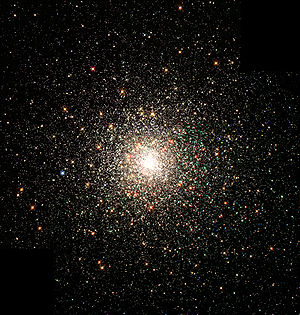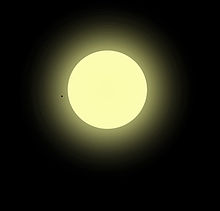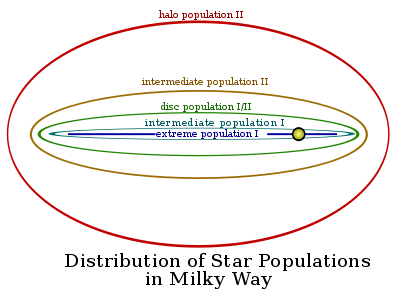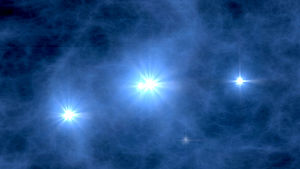- Metallicity
-
 The globular cluster M80. Stars in globular clusters are mainly older metal-poor members of Population II.
The globular cluster M80. Stars in globular clusters are mainly older metal-poor members of Population II.
In astronomy and physical cosmology, the metallicity (also called Z[1]) of an object is the proportion of its matter made up of chemical elements other than hydrogen and helium. Since stars, which comprise most of the visible matter in the universe, are composed mostly of hydrogen and helium, astronomers use for convenience the blanket term "metal" to describe all other elements collectively.[2] Thus, a nebula rich in carbon, nitrogen, oxygen, and neon would be "metal-rich" in astrophysical terms even though those elements are non-metals in chemistry. This term should not be confused with the usual definition of "metal"; metallic bonds are impossible within stars, and the very strongest chemical bonds are only possible in the outer layers of cool K and M stars. Normal chemistry therefore has little or no relevance in stellar interiors.
The metallicity of an astronomical object may provide an indication of its age. When the universe first formed, according to the Big Bang theory, it consisted almost entirely of hydrogen which, through primordial nucleosynthesis, created a sizeable proportion of helium and only trace amounts of lithium and beryllium and no heavier elements. Therefore, older stars have lower metallicities than younger stars such as our Sun.
Contents
Populations III, II, and I
Stellar populations are categorized as I, II, and III, with each group having decreasing metal content and increasing age. The populations were named in the order they were discovered, which is the reverse of the order they were created. Thus, the first stars in the universe (low metal content) were population III, and recent stars (high metallicity) are population I.
While older stars do have fewer heavy elements, the fact that all stars observed have some heavier elements poses something of a puzzle, and the current explanation for this proposes the existence of hypothetical metal-free Population III stars in the early universe. Soon after the Big Bang, without metals, it is believed that only stars with masses hundreds of times that of the Sun could be formed; near the end of their lives these stars would have created the first 26 elements up to iron in the periodic table via nucleosynthesis.[3]
Because of their high mass, current stellar models show that Population III stars would have soon exhausted their fuel and exploded in extremely energetic pair-instability supernovae. Those explosions would have thoroughly dispersed their material, ejecting metals throughout the universe to be incorporated into the later generations of stars that are observed today. The high mass of the first stars is used to explain why, as of 2010[update], no Population III stars have been observed. Because they were all destroyed in supernovae in the early universe, Population III stars should only be seen in faraway galaxies whose light originated much earlier in the history of the universe, and searching for these stars or establishing their nonexistence (thereby invalidating the current model) is an active area of research in astronomy. Stars too massive to produce pair-instability supernovae would have collapsed into black holes through a process known as photodisintegration, but some matter escapes during this process in the form of relativistic jets, and this could have "sprayed" the first metals into the universe.[4][5]
It has been proposed that recent supernovae SN 2006gy and SN 2007bi may have been pair-instability supernovae in which such super-massive Population III stars exploded. It has been speculated that these stars could have formed relatively recently in dwarf galaxies containing primordial metal-free interstellar matter; past supernovae in these galaxies could have ejected their metal-rich contents at speeds high enough for them to escape the galaxy, keeping the metal content of the galaxy very low.[6]
The next generation of stars was born out of those materials left by the death of the first. The oldest observed stars, known as Population II, have very low metallicities;[7][8] as subsequent generations of stars were born they became more metal-enriched, as the gaseous clouds from which they formed received the metal-rich dust manufactured by previous generations. As those stars died, they returned metal-enriched material to the interstellar medium via planetary nebulae and supernovae, enriching the nebulae out of which the newer stars formed ever further. These youngest stars, including the Sun, therefore have the highest metal content, and are known as Population I stars.
Across the Milky Way, metallicity is higher in the galactic centre and decreases as one moves outwards. The gradient in metallicity is attributed to the density of stars in the galactic centre: there are more stars in the centre of the galaxy and so, over time, more metals have been returned to the interstellar medium and incorporated into new stars. By a similar mechanism, larger galaxies tend to have a higher metallicity than their smaller counterparts. In the case of the Magellanic Clouds, two small irregular galaxies orbiting (see note about newest research [1]) the Milky Way, the Large Magellanic Cloud has a metallicity of about forty per cent of the Milky Way, while the Small Magellanic Cloud has a metallicity of about ten per cent of the Milky Way.
Calculation
The metallicity of the Sun is approximately 1.8 percent by mass. For other stars, the metallicity is often expressed as "[Fe/H]", which represents the logarithm of the ratio of a star's iron abundance compared to that of the Sun (iron is not the most abundant heavy element, but it is among the easiest to measure with spectral data in the visible spectrum). The formula for the logarithm is expressed thus:
![[\mathrm{Fe}/\mathrm{H}] = \log_{10}{\left(\frac{N_{\mathrm{Fe}}}{N_{\mathrm{H}}}\right)_{star}} - \log_{10}{\left(\frac{N_{\mathrm{Fe}}}{N_{\mathrm{H}}}\right)_{sun}}](9/5e94f3081d84dda270d98cff86433233.png)
where NFe and NH are the number of iron and hydrogen atoms per unit of volume respectively. The unit often used for metallicity is the "dex" which is a (now-deprecated) contraction of decimal exponent.[9] By this formulation, stars with a higher metallicity than the Sun have a positive logarithmic value, while those with a lower metallicity than the Sun have a negative value. The logarithm is based on powers of ten; stars with a value of +1 have ten times the metallicity of the Sun (101). Conversely, those with a value of -1 have one tenth (10 −1), while those with -2 have a hundredth (10−2), and so on.[2] Young Population I stars have significantly higher iron-to-hydrogen ratios than older Population II stars. Primordial Population III stars are estimated to have a metallicity of less than −6.0, that is, less than a millionth of the abundance of iron which is found in the Sun.
This same sort of notation is used to express differences in the individual elements from the solar proportion. For example, the notation "[O/Fe]" represents the difference in the logarithm of the star's oxygen abundance compared to that of the Sun and the logarithm of the star's iron abundance compared to the Sun:
![[\mathrm{O}/\mathrm{Fe}] = \log_{10}{\left(\frac{N_{\mathrm{O}}}{N_{\mathrm{Fe}}}\right)_{star}} - \log_{10}{\left(\frac{N_{\mathrm{O}}}{N_{\mathrm{Fe}}}\right)_{sun}}](1/f110e7eacf596a8976b485b8d6a44c21.png)
![= \left[\log_{10}{\left(\frac{N_{\mathrm{O}}}{N_{\mathrm{H}}}\right)_{star}} - \log_{10}{\left(\frac{N_{\mathrm{O}}}{N_{\mathrm{H}}}\right)_{sun}}\right] -
\left[\log_{10}{\left(\frac{N_{\mathrm{Fe}}}{N_{\mathrm{H}}}\right)_{star}} - \log_{10}{\left(\frac{N_{\mathrm{Fe}}}{N_{\mathrm{H}}}\right)_{sun}}\right]](4/5e42914ef07bc39225b0f0f595127d97.png)
The point of this notation is that if a mass of gas is diluted with pure hydrogen, then its [Fe/H] value will decrease (since there are fewer iron atoms per hydrogen atom after the dilution), but for all other elements X, the [X/Fe] ratios will remain unchanged. By contrast, if a mass of gas is polluted with some amount of pure oxygen, then its [Fe/H] will remain unchanged but its [O/Fe] ratio will increase. In general, a given stellar nucleosynthetic process alters the proportions of only a few elements or isotopes, so a star or gas sample with nonzero [X/Fe] values may be showing the signature of particular nuclear processes.
Population I stars
Population I or metal-rich stars are those young stars whose metallicity is highest. The Earth's Sun is an example of a metal-rich star. These are common in the spiral arms of the Milky Way galaxy.
Generally, the youngest stars, the extreme Population I, are found farther in and intermediate Population I stars are farther out, etc. The Sun is considered an intermediate Population I star. Population I stars have regular elliptical orbits of the galactic centre, with a low relative velocity. The high metallicity of Population I stars makes them more likely to possess planetary systems than the other two populations, since planets, particularly terrestrial planets, are thought to be formed by the accretion of metals.[10]
Between the intermediate populations I and II comes the intermediary disc population.
Population II stars
Population II, or metal-poor stars, are those with relatively little metal. The idea of a relatively small amount must be kept in perspective as even metal-rich astronomical objects contain low quantities of any element other than hydrogen or helium; metals constitute only a tiny percentage of the overall chemical makeup of the universe, even 13.7 billion years after the Big Bang. However, metal-poor objects are even more primitive. These objects formed during an earlier time of the universe. Intermediate Population II stars are common in the bulge near the centre of our galaxy; whereas Population II stars found in the galactic halo are older and thus more metal-poor. Globular clusters also contain high numbers of Population II stars.[11] It is believed that Population II stars created all the other elements in the periodic table, except the more unstable ones.
Scientists have targeted these oldest stars in several different surveys, including the HK objective-prism survey of Timothy C. Beers et al. and the Hamburg-ESO survey of Norbert Christlieb et al., originally started for faint quasars. Thus far, they have uncovered and studied in detail about ten very metal-poor stars (as CS22892-052, CS31082-001, BD +17° 3248) and two of the oldest stars known to date and also the oldest star: HE0107-5240 and HE1327-2326 and HE 1523-0901. Less extreme in their metal deficiency, but nearer and brighter and hence longer known, are HD 122563 (a red giant) and HD 140283 (a subgiant).
Population III stars
 Possible glow of Population III stars imaged by NASA's Spitzer Space Telescope.
Possible glow of Population III stars imaged by NASA's Spitzer Space Telescope.
Credit: NASA / JPL-Caltech / A. Kashlinsky (GSFC)Population III, or metal-free stars is a hypothetical extinct population of extremely massive and hot stars with virtually no surface metals, except for a small quantity of metals formed in the Big Bang, such as lithium-7. These stars are believed to have been formed in the early universe. Their existence is inferred from cosmology, but they have not yet been observed directly. Indirect evidence for their existence has been found in a gravitationally lensed galaxy in a very distant part of the universe.[12] They are also thought to be components of faint blue galaxies. Their existence is proposed to account for the fact that heavy elements, which could not have been created in the Big Bang, are observed in quasar emission spectra, as well as the existence of faint blue galaxies.[3] It is believed that these stars triggered a period of reionization. UDFy-38135539, a galaxy recently discovered, is believed to have been a part of this process.
Current theory is divided on whether the first stars were very massive or not. One theory, which seems to be borne out by computer models of star formation, is that with no heavy elements from the Big Bang, it was easy to form stars with much more total mass than the ones visible today. Typical masses for Population III stars would be expected to be about several hundred solar masses, which is much larger than the current stars. Analysis of data on extremely low-metallicity Population II stars such as HE0107-5240, which are thought to contain the metals produced by Population III stars, suggest that these metal-free stars had masses of 20 to 130 solar masses instead.[13] On the other hand, analysis of globular clusters associated with elliptical galaxies suggests pair-instability supernovae were responsible for their metallic composition.[14] This also explains why there have been no low-mass stars with zero metallicity observed, although models have been constructed for smaller Population III stars.[15] Clusters containing zero-metallicity red dwarfs or brown dwarfs (possibly created by pair-instability supernovae[8]) have been proposed as dark matter candidates, but there is disagreement on this theory.[16][17] Confirmation of these theories awaits the launch of NASA's James Webb Space Telescope. New spectroscopic surveys, such as SEGUE or SDSS-II, may also locate Population III stars.
A recent theory suggests the first star groups may have consisted of a massive star surrounded by several smaller stars.[18]
See also
Sources
- Page 593-In Quest of the Universe Fourth Edition Karl F. Kuhn Theo Koupelis. Jones and Bartlett Publishers Canada. 2004. ISBN 0-7637-0810-0
- Bromm, Volker; Larson, Richard B. (2004). "THE FIRST STARS". Annual Review of Astronomy and Astrophysics 42: 79–118. arXiv:astro-ph/0311019. Bibcode 2004ARA&A..42...79B. doi:10.1146/annurev.astro.42.053102.134034.
- ^ http://ned.ipac.caltech.edu/level5/Kunth/Kunth1.html
- ^ a b John C. Martin. "What we learn from a star's metal content". New Analysis RR Lyrae Kinematics in the Solar Neighborhood. https://edocs.uis.edu/jmart5/www/rrlyrae/metals.htm. Retrieved September 7, 2005.
- ^ a b A. Heger, S. E. Woosley (2002). "The Nucleosynthetic Signature of Population III". Astrophysical Journal 567 (1): 532–543. arXiv:astro-ph/0107037. Bibcode 2002ApJ...567..532H. doi:10.1086/338487.
- ^ Fryer, C. L.; Woosley, S. E.; Heger, A. (2001). "Pair-Instability Supernovae, Gravity Waves, and Gamma-Ray Transients". The Astrophysical Journal 550: 372. arXiv:astro-ph/0007176. Bibcode 2001ApJ...550..372F. doi:10.1086/319719.
- ^ Heger, A.; Fryer, C. L.; Woosley, S. E.; Langer, N.; Hartmann, D. H. (2003). "How Massive Single Stars End Their Life". The Astrophysical Journal 591: 288. arXiv:astro-ph/0212469. Bibcode 2003ApJ...591..288H. doi:10.1086/375341.
- ^ New Scientist article on pair-instability supernovae, 13 February 2010
- ^ Lauren J. Bryant. "What Makes Stars Tick". Indiana University Research & Creative Activity. http://www.indiana.edu/~rcapub/v27n1/tick.shtml. Retrieved September 7, 2005.
- ^ a b Salvaterra, R.; Ferrara, A.; Schneider, R. (2004). "Induced formation of primordial low-mass stars". New Astronomy 10 (2): 113. arXiv:astro-ph/0304074. Bibcode 2004NewA...10..113S. doi:10.1016/j.newast.2004.06.003.
- ^ A Dictionary of Units of Measurement
- ^ Charles H. Lineweaver (2000). "An Estimate of the Age Distribution of Terrestrial Planets in the Universe: Quantifying Metallicity as a Selection Effect". Icarus 151 (2): 307–313. arXiv:astro-ph/0012399. Bibcode 2001Icar..151..307L. doi:10.1006/icar.2001.6607.
- ^ T. S. van Albada, Norman Baker (1973). "On the Two Oosterhoff Groups of Globular Clusters". Astrophysical Journal 185: 477–498. Bibcode 1973ApJ...185..477V. doi:10.1086/152434.
- ^ R. A. E. Fosbury et al. (2003). "Massive Star Formation in a Gravitationally Lensed H II Galaxy at z = 3.357". Astrophysical Journal 596 (1): 797–809. arXiv:astro-ph/0307162. Bibcode 2003ApJ...596..797F. doi:10.1086/378228. http://iopscience.iop.org/0004-637X/596/2/797/pdf/0004-637X_596_2_797.pdf.
- ^ Umeda, Hideyuki; Nomoto, Ken'Ichi (2003). "First-generation black-hole-forming supernovae and the metal abundance pattern of a very iron-poor star". Nature 422 (6934): 871–873. arXiv:astro-ph/0301315. Bibcode 2003Natur.422..871U. doi:10.1038/nature01571. PMID 12712199.
- ^ Puzia, Thomas H.; Kissler‐Patig, Markus; Goudfrooij, Paul (2006). "Extremely α‐Enriched Globular Clusters in Early‐Type Galaxies: A Step toward the Dawn of Stellar Populations?". The Astrophysical Journal 648: 383–388. arXiv:astro-ph/0605210. Bibcode 2006ApJ...648..383P. doi:10.1086/505679.
- ^ Siess, Lionel; Livio, Mario; Lattanzio, John (2002). "Structure, Evolution, and Nucleosynthesis of Primordial Stars". The Astrophysical Journal 570: 329–343. arXiv:astro-ph/0201284. Bibcode 2002ApJ...570..329S. doi:10.1086/339733.
- ^ Kerins, E. J. (1997). "Zero-metallicity very low mass stars as halo dark matter". Astronomy and Astrophysics 322: 709. arXiv:astro-ph/9610070. Bibcode 1997A&A...322..709K.
- ^ Sanchez-Salcedo, F. J. (1997). "On the Stringent Constraint on Massive Dark Clusters in the Galactic Halo". Astrophysical Journal Letters v.487 487: L61. Bibcode 1997ApJ...487L..61S. doi:10.1086/310873.
- ^ The Universe's First Stars Weren't Loners After All
Categories:- Astrophysics
- Physical cosmology
- Stellar astronomy
Wikimedia Foundation. 2010.



